Biology
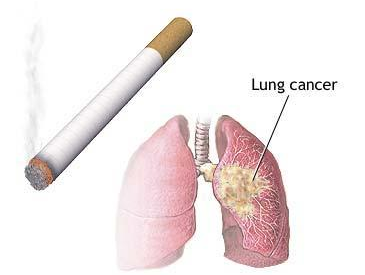 Smoking is one of the major avoidable risk factors of chronic, life-threatening diseases of the gas exchange and circulatory systems.
Smoking is one of the major avoidable risk factors of chronic, life-threatening diseases of the gas exchange and circulatory systems.
The smoke from cigarettes contains several substances that affect the gas exchange system and the cardiovascular system. These include:
? tar, a mixture of substances including various chemicals that act as carcinogens.
? nicotine, an addictive substance that affects the nervous system by binding to receptors on neurones (nerve cells) in the brain and other parts of the body. It increases the release of a neurotransmitter called dopamine in the brain, which gives feelings of pleasure. It increases the release of adrenaline into the blood, which in turn increases breathing rate and heart rate. There is also some evidence that nicotine increases the likelihood of blood clots forming.
? CO, which combines irreversibly with Hb, forming carboxyhaemoglobin. This reduces the amount of Hb available to combine with O2, and so reduces the amount of O2 that is transported to body tissues.
Effects of smoking on the gas exchange system
Chronic obstructive pulmonary disease (COPD)
This is a condition in which a person has chronic bronchitis and emphysema. It can be extremely disabling.
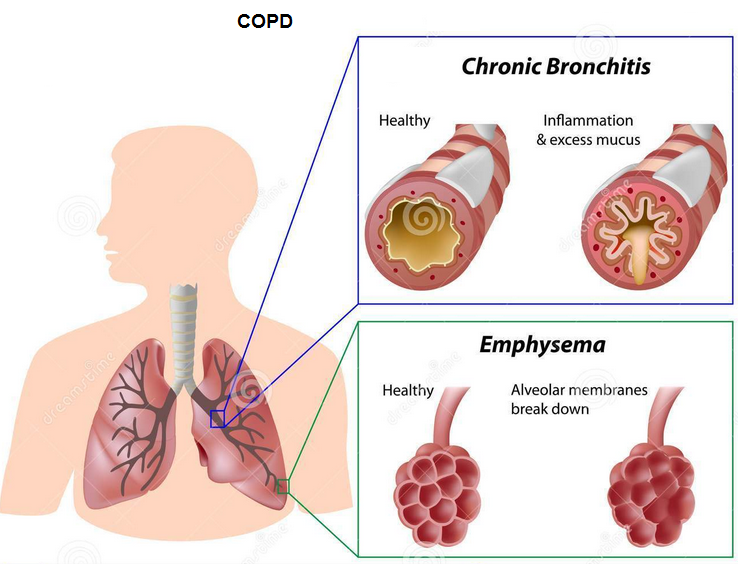
Chronic bronchitis
Various components of cigarette smoke, including tar, cause goblet cells to increase mucus production and cilia to beat less strongly. This causes mucus to build up, which may partially block alveoli. This makes gas exchange more difficult, as the diffusion distance between the air in the alveoli and the blood in the capillaries is greater. The mucus may become infected with bacteria, causing bronchitis. Smokers often have chronic (long-lasting) bronchitis.
The mucus stimulates persistent coughing, which can damage the tissues in the walls of the airways, making them stiffer and the airways narrower.
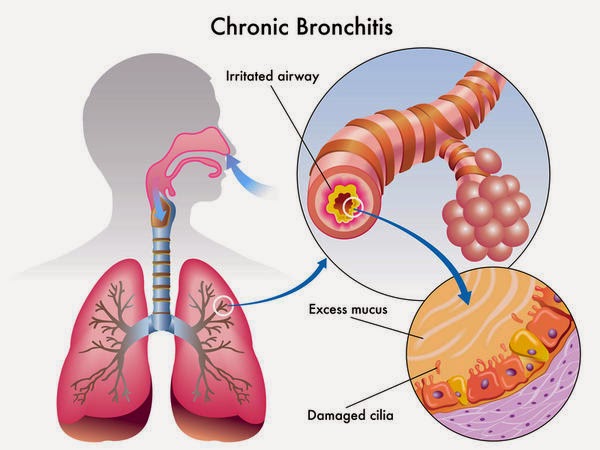
Emphysema
Smoking causes inflammation in the lungs. This involves the presence of increased numbers of white blood cells, some of which secrete chemicals that damage elastic fibres. This makes the alveoli less elastic. They may burst, resulting in larger air spaces. This reduces the surface area available for gas exchange. This is called emphysema. A person with emphysema has shortness of breath, meaning they struggle to breathe as deeply as they need to, especially when exercising.
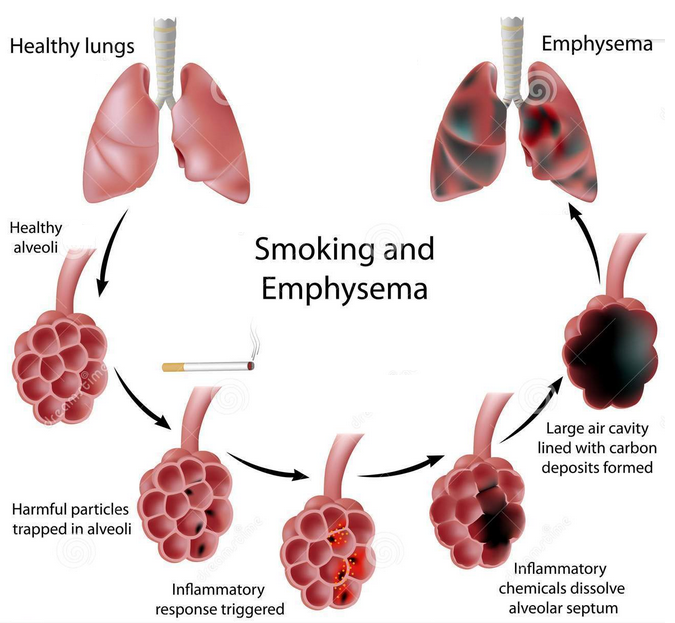
Lung cancer
Various components of tar can cause changes in the DNA in body cells, including the genes that control cell division, which can cause cancer. These substances are therefore carcinogens. Cancers caused by cigarette smoke are most likely to form in the lungs but may form anywhere in the gas exchange system, and also in other parts of the body. Smoking increases the risk of developing all types of cancer. Symptoms of lung cancer include shortness of breath, a chronic cough - which may
bring up blood - chest pain, fatigue and weight loss.
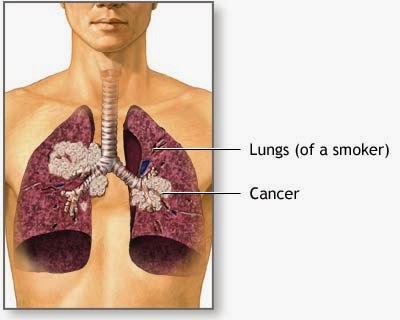
Effects of smoking on the cardiovascular system
The nicotine and CO in tobacco smoke increase the risk of developing atherosclerosis. Atherosclerosis is a thickening and loss of elasticity in the walls of arteries. It is caused by build-up of plaques in the blood vessel wall. The plaques contain cholesterol and fibres. They produce a rough surface lining the artery, which stimulates the formation of blood clots.
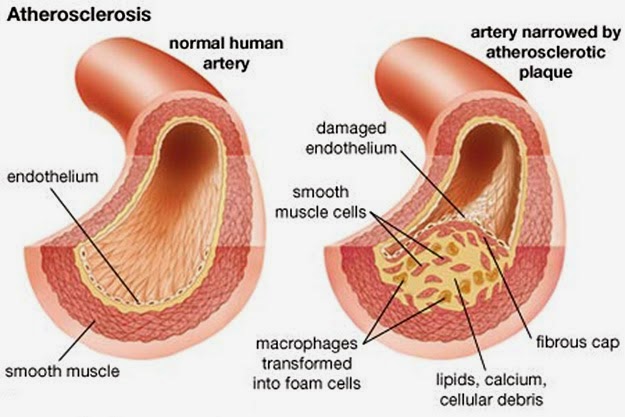
A blood clot may break away from the artery wall and get stuck in a narrow vessel elsewhere in the blood system, for example in the lungs or in the brain. This prevents blood passing through so cells are not supplied with O2 and die. If this happens in the brain it is called a stroke.
The loss of elasticity In an artery or arteriole also makes it more likely that the vessel will burst when high-pressure blood pulses through. This is another cause of stroke.
If atherosclerosis happens in the coronary arteries that supply the heart muscle with oxygenated blood, the person has coronary heart disease (CHD). Parts of the muscle may be unable to function properly as they do not have enough O2 for aerobic respiration. The muscle may die. Eventually, this part of the heart may stop beating, causing a heart attack.
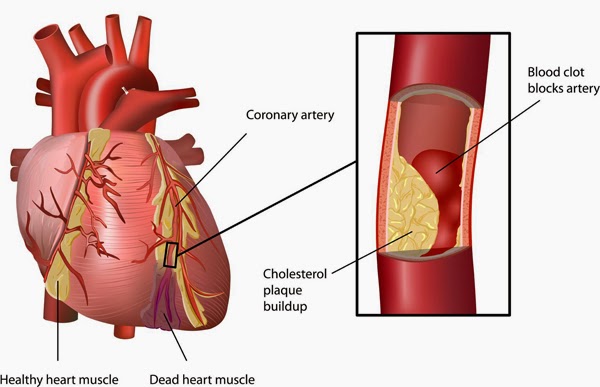
Evidence for effects of smoking on health
There are two ways in which the effects of smoking on health can be investigated.
Epidemiological evidence
This consists of data collected about people's smoking habits and their health. Large numbers of people should be involved in the study. The researchers then look for correlations between smoking and particular diseases. Although this approach does not provide any definite evidence about a causal link between smoking and the disease, it can at least show whether there could be a causal relationship. If we then have physiological evidence to show how smoking might cause the disease, then this adds up to strong evidence that smoking does indeed cause the disease.
Experimental evidence
This consists of carrying out controlled experiments. For example, the independent variable could be whether or not a subject smokes (or how much they smoke) and the dependent variable could be some aspect of physiology. All other variables should be kept constant. This is not possible with humans, as it would be unethical to make people smoke. In the 1960s, dogs and other animals were used in such experiments. The results showed conclusively that smoking tobacco greatly increases the risk of developing lung cancer. Experiments can also be carried out using cells grown in
tissue culture. Exposure of these cells to chemicals found in tar shows that these chemicals can damage DNA.
Preventing and treating CHD
The risk of developing CHD is increased by:
? inheriting particular alleles of genes
? eating a diet rich in saturated fats and cholesterol
? not taking sufficient exercise
? being obese
? smoking
Severe CHD can be treated with a coronary bypass, in which a piece of blood vessel is taken from another part of the body and sewn into place to provide an alternative route for oxygenated blood to flow from the aorta to the heart muscle.
If the heart is damaged beyond repair, either by CHD or other conditions, then the only long-term option may be a heart transplant. The heart must come from a person who has just died (often in an accident) and has a tissue type that is similar to the recipient. Even so, the recipient will still have to take immunosuppressant drugs for the rest of their life, to prevent their immune system from attacking the donor tissues and rejecting the transplant.
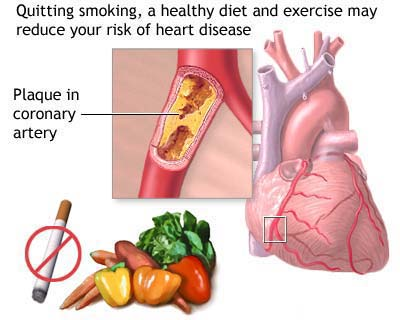
Prevention of CHD and other forms of heart disease is clearly much better than having to carry out complex surgery. Lifestyle choices can be made that reduce the risks listed above (apart, of course, from the genes a person has). However, research shows that slightly obese people are more likely to recover well after heart surgery than thinner people.
- #53 Summary Of Smoking
1 Tobacco smoke contains tar, carbon monoxide and nicotine. 2 Tar settles on the epithelium lining the bronchi and bronchioles and stimulates inflammation, an increase in the secretion of mucus and an accumulation of phagocytes...
- #50 The Gas Exchange System
All organisms take in gases from their environment and release gases to the environment. Animals take in O2 for aerobic respiration and release CO2. Plants also respire, but during daylight hours they photosynthesise at a greater rate than...
- #49.2 Gas Exchange And Smoking Syllabus 2016
9.1 The gas exchange system 9.2 Smoking The gas exchange system is responsible for the uptake of oxygen into the blood and excreting carbon dioxide. An understanding of this system shows how cells, tissues and organs function...
- # 44 The Circulatory System - Blood Vessels
The mammalian circulatory system is a closed double circulation, consisting of a heart, blood vessels and blood. The heart produces high pressure --> blood moves through the vessels by mass flow. The mammalian...
- Heart, Blood & Blood Vessels- Facts
The human body has approximately 37,000 miles of capillaries.The aorta, which is largest artery located in the body, is about the diameter of a garden hose.Women hearts beat faster than men.Three years after a person quits smoking, there chance of having...
Biology
#52 Cigarette smoking and health

The smoke from cigarettes contains several substances that affect the gas exchange system and the cardiovascular system. These include:
? tar, a mixture of substances including various chemicals that act as carcinogens.
? nicotine, an addictive substance that affects the nervous system by binding to receptors on neurones (nerve cells) in the brain and other parts of the body. It increases the release of a neurotransmitter called dopamine in the brain, which gives feelings of pleasure. It increases the release of adrenaline into the blood, which in turn increases breathing rate and heart rate. There is also some evidence that nicotine increases the likelihood of blood clots forming.
? CO, which combines irreversibly with Hb, forming carboxyhaemoglobin. This reduces the amount of Hb available to combine with O2, and so reduces the amount of O2 that is transported to body tissues.
Effects of smoking on the gas exchange system
Chronic obstructive pulmonary disease (COPD)
This is a condition in which a person has chronic bronchitis and emphysema. It can be extremely disabling.

Various components of cigarette smoke, including tar, cause goblet cells to increase mucus production and cilia to beat less strongly. This causes mucus to build up, which may partially block alveoli. This makes gas exchange more difficult, as the diffusion distance between the air in the alveoli and the blood in the capillaries is greater. The mucus may become infected with bacteria, causing bronchitis. Smokers often have chronic (long-lasting) bronchitis.
The mucus stimulates persistent coughing, which can damage the tissues in the walls of the airways, making them stiffer and the airways narrower.

Smoking causes inflammation in the lungs. This involves the presence of increased numbers of white blood cells, some of which secrete chemicals that damage elastic fibres. This makes the alveoli less elastic. They may burst, resulting in larger air spaces. This reduces the surface area available for gas exchange. This is called emphysema. A person with emphysema has shortness of breath, meaning they struggle to breathe as deeply as they need to, especially when exercising.

Lung cancer
Various components of tar can cause changes in the DNA in body cells, including the genes that control cell division, which can cause cancer. These substances are therefore carcinogens. Cancers caused by cigarette smoke are most likely to form in the lungs but may form anywhere in the gas exchange system, and also in other parts of the body. Smoking increases the risk of developing all types of cancer. Symptoms of lung cancer include shortness of breath, a chronic cough - which may
bring up blood - chest pain, fatigue and weight loss.

Effects of smoking on the cardiovascular system
The nicotine and CO in tobacco smoke increase the risk of developing atherosclerosis. Atherosclerosis is a thickening and loss of elasticity in the walls of arteries. It is caused by build-up of plaques in the blood vessel wall. The plaques contain cholesterol and fibres. They produce a rough surface lining the artery, which stimulates the formation of blood clots.

A blood clot may break away from the artery wall and get stuck in a narrow vessel elsewhere in the blood system, for example in the lungs or in the brain. This prevents blood passing through so cells are not supplied with O2 and die. If this happens in the brain it is called a stroke.
The loss of elasticity In an artery or arteriole also makes it more likely that the vessel will burst when high-pressure blood pulses through. This is another cause of stroke.
If atherosclerosis happens in the coronary arteries that supply the heart muscle with oxygenated blood, the person has coronary heart disease (CHD). Parts of the muscle may be unable to function properly as they do not have enough O2 for aerobic respiration. The muscle may die. Eventually, this part of the heart may stop beating, causing a heart attack.

Evidence for effects of smoking on health
There are two ways in which the effects of smoking on health can be investigated.
Epidemiological evidence
This consists of data collected about people's smoking habits and their health. Large numbers of people should be involved in the study. The researchers then look for correlations between smoking and particular diseases. Although this approach does not provide any definite evidence about a causal link between smoking and the disease, it can at least show whether there could be a causal relationship. If we then have physiological evidence to show how smoking might cause the disease, then this adds up to strong evidence that smoking does indeed cause the disease.
Experimental evidence
This consists of carrying out controlled experiments. For example, the independent variable could be whether or not a subject smokes (or how much they smoke) and the dependent variable could be some aspect of physiology. All other variables should be kept constant. This is not possible with humans, as it would be unethical to make people smoke. In the 1960s, dogs and other animals were used in such experiments. The results showed conclusively that smoking tobacco greatly increases the risk of developing lung cancer. Experiments can also be carried out using cells grown in
tissue culture. Exposure of these cells to chemicals found in tar shows that these chemicals can damage DNA.
Preventing and treating CHD
The risk of developing CHD is increased by:
? inheriting particular alleles of genes
? eating a diet rich in saturated fats and cholesterol
? not taking sufficient exercise
? being obese
? smoking
Severe CHD can be treated with a coronary bypass, in which a piece of blood vessel is taken from another part of the body and sewn into place to provide an alternative route for oxygenated blood to flow from the aorta to the heart muscle.
If the heart is damaged beyond repair, either by CHD or other conditions, then the only long-term option may be a heart transplant. The heart must come from a person who has just died (often in an accident) and has a tissue type that is similar to the recipient. Even so, the recipient will still have to take immunosuppressant drugs for the rest of their life, to prevent their immune system from attacking the donor tissues and rejecting the transplant.

Prevention of CHD and other forms of heart disease is clearly much better than having to carry out complex surgery. Lifestyle choices can be made that reduce the risks listed above (apart, of course, from the genes a person has). However, research shows that slightly obese people are more likely to recover well after heart surgery than thinner people.
| Syllabus 2015 (e) describe the effects of tar and carcinogens in tobacco smoke on the gas exchange system; (f) describe the signs and symptoms that enable diagnosis of lung cancer and chronic obstructive pulmonary disease (COPD) (emphysema and chronic bronchitis); (g) describe the effects of nicotine and carbon monoxide on the cardiovascular system; (h) explain how tobacco smoking contributes to atherosclerosis and coronary heart disease (CHD); (i) evaluate the epidemiological and experimental evidence linking cigarette smoking to disease and early death; (j) discuss the difficulties in achieving a balance between preventions and cure with reference to coronary heart disease, coronary by-pass surgery and heart transplant surgery; |
Syllabus: 9.2 Smoking Smoking is one of the major avoidable risk factors of chronic, life-threatening diseases of the gas exchange and circulatory systems. a) describe the effects of tar and carcinogens in tobacco smoke on the gas exchange system with reference to lung cancer and chronic obstructive pulmonary disease (COPD) b) describe the short-term effects of nicotine and carbon monoxide on the cardiovascular system |
- #53 Summary Of Smoking
1 Tobacco smoke contains tar, carbon monoxide and nicotine. 2 Tar settles on the epithelium lining the bronchi and bronchioles and stimulates inflammation, an increase in the secretion of mucus and an accumulation of phagocytes...
- #50 The Gas Exchange System
All organisms take in gases from their environment and release gases to the environment. Animals take in O2 for aerobic respiration and release CO2. Plants also respire, but during daylight hours they photosynthesise at a greater rate than...
- #49.2 Gas Exchange And Smoking Syllabus 2016
9.1 The gas exchange system 9.2 Smoking The gas exchange system is responsible for the uptake of oxygen into the blood and excreting carbon dioxide. An understanding of this system shows how cells, tissues and organs function...
- # 44 The Circulatory System - Blood Vessels
The mammalian circulatory system is a closed double circulation, consisting of a heart, blood vessels and blood. The heart produces high pressure --> blood moves through the vessels by mass flow. The mammalian...
- Heart, Blood & Blood Vessels- Facts
The human body has approximately 37,000 miles of capillaries.The aorta, which is largest artery located in the body, is about the diameter of a garden hose.Women hearts beat faster than men.Three years after a person quits smoking, there chance of having...
